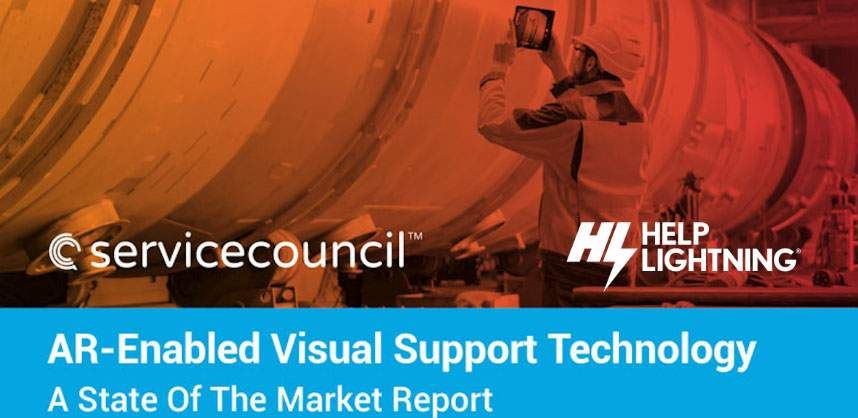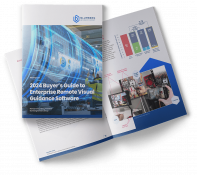Help Lightning Blog
AR-Enabled Visual Support Technology: State of the Market, November 2021

This fall, we teamed up with The Service Council to combine benchmark research, new primary research and a few smart minds to create the industry’s first State of the Market report for AR-Enabled Visual Support Technology.
We’re excited to share a summary here on the blog. A full report is available as a free download you can share with others. A huge thanks to John Carroll and the entire team at The Service Council. Their amazing work resulted in this final report.
Table of Contents: AR-Enabled Visual Support Technology
Executive Summary
- Service Industry Trends Driving Transformation Opportunity
- About the Research Project
A History of AR-Enabled Visual Support Technology (AR-VST)
Augmented Reality (AR) Benchmark
- Market Perception (Anticipated Results)
- Market Reality (Realized Results)
Voice of the Field Service Engineer (VoFSE)
- Field Service Work Driving Need for Information
- Knowledge Exodus Caused by Aging Workforce + Engagement Challenges
State of the Market (Current Assessment)
Recommendations for Action
- Field Service Work Driving Need for Information
- Knowledge Exodus Caused by Aging Workforce + Engagement Challenges
Executive Summary
Over the last decade, digital transformation has brought forth new technologies enabling customer, technical and field service support. This has resulted in the emergence of new technology categories. These aim to establish a communication platform to bridge the gap between digital and physical worlds. Technologies such as Augmented Reality (AR), Virtual Reality (VR), Mixed/Merged Reality (MR) and Extended Reality (XR). These technologies empower organizations to distribute information at the point of service and support. Service leaders aim to create an information exchange platform inclusive of (but not limited to) the technologies above. This reinforces the value of a proven category: AR-Enabled Visual Support Technology (VST). VST has become essential to customer, technical and field service support delivery. Arguably, just as essential as traditional technologies such as Customer Relationship Management (CRM) and Field Service Management (FSM) platforms over the previous decade(s).
Technology Drivers
What is driving the emergence of this technology category and the realization of its positive impact on key service metrics? A summary of contributing factors:
- An increase in customer demands and pressure for faster delivery. Example: customer empowerment for immediacy (speed/pace). Also, visibility of service delivery which leading brands such as Amazon and Uber have pioneered
- An evolution of preferred service delivery channel by customers. A requirement of proactive/predictive delivery models, preference of self-service, Do-it-Yourself – DIY, digital-first).
- An increase in product sophistication (i.e., technical requirements)
- A decrease in skilled workforce availability (i.e., aging/retiring workforce – often called the “Silver Tsunami”. It’s a trades skillset shortage fueled by low engagement among the younger field technician demographic)
The above represents a few of the issues which are driving the emergence of VST. The pandemic of 2020 (and current) only served to accelerate the need to deploy VST as a priority in our digital transformation initiatives. Most of which are geared towards solving two of the most important focus areas of service leaders: customer experience and cost. A third (and equivalent) focus area is revenue, which represents an additional opportunity for service organizations.
A New Focus On Growth
Many service leaders have turned their attention from a business continuity (survive) focus in 2020 to a growth (thrive) focus in 2021 and beyond. They have placed additional pressure on the service business for profit and margin contribution. Service leaders continue to evolve their service revenue offerings and the capturing/ disseminating of knowledge and accessibility of Subject Matter Experts (SMEs). Those aided through VST will become vital to growth initiatives. Side note: according to the 2021 Service Leader’s Agenda benchmark survey, “Service Revenue” was highlighted as the metric most focused on in 2021.
The three contributing factors above are supported by recent Service CouncilTM research. This witnessed 100+ Service Executive respondents from an array of industries including high tech, medical/healthcare, industrial manufacturing and more. According to the 2021 Service Leader’s Agenda benchmark survey, the top 2 internal and external challenges (Figure 1: Service Leader’s Agenda: Internal & External Challenges):

A third internal challenge (also at 27% of respondents) was “outdated service processes”. This builds support for the changing customer preferences (self-service) factor also highlighted above. Service leaders are typically grappling with the balancing of three primary objectives: cost, revenue & customer experience.
The Increasing Importance Of AR-Enabled Visual Support Technology
VST projects are to be just as pervasive in the coming decade (and much sooner) as mainstream technology platforms commonly deployed and utilized by service organizations (e.g., CRM, FSM, etc.). As the demands being placed on service for greater profit contribution continue to increase, service delivery and cost initiatives will also be prioritized with great focus. Service leaders will emphasize triage & diagnosis accuracy, remote resolution, and first-time-fix rates (in the event of a dispatch) which VST aims to address. Beyond the contribution to profit and margin because of service delivery efficiency gains noted, VST can also support humanitarian efforts for sustainability. The elimination of dispatches (commonly referred to as truck rolls) via remote resolution or through the elimination of repeat visits, serves to support Net Zero by 2050 initiatives which many corporations globally have rightfully rallied behind.
This summary report highlights the State of the AR-Enabled Visual Support Technology Market. There is an analysis of how these technologies have evolved since the original survey. And a suggestion about how that evolution is likely to continue over the next two years is evaluated. The report combines analysis from the following data sources:
- (H1 2017) The Feasibility of Augmented Reality (AR) in Service (225+ executive respondents, 20+ executive interviews)
- (H1 2021) Voice of the Field Service Engineer (VoFSE) (850+ technician/ engineer respondents)
- (H2 2021) Technology Investment Plans survey (90+ executive respondents)
Download the full report or watch the October 2021 webinar with a discussion of the initial results. You’ll enjoy the customer perspective from Fidel Zamudio of BD.
Ready to learn more about Help Lightning? Request a demo.












